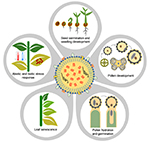Here, there and everywhere – the importance of neutral lipids in plant growth and development
DOI:
https://doi.org/10.18388/pb.2021_409Abstract
In plants, lipids serve as one of the major and vital cellular constituents. Neutral lipids reserves play an essential role in the plant life cycle by providing carbon and energy equivalents for periods of active metabolism. The most common form of lipid storage are triacylglycerols (TAGs) packed into specialized organelles called lipid droplets (LDs). They have been observed in diverse plant organs and tissues, like oil seeds or pollen grains. LDs consist of a core, composed mostly of TAGs, enclosed by a single layer of phospholipids that is decorated by a unique set of structural proteins. Moreover, the recent advances in exploration of LDs proteome revealed a plethora of diverse proteins interacting with LDs. This is likely the result of a highly dynamic nature of these organelles and their involvement in many diverse aspect of cellular metabolism, tightly synchronized with plant developmental programs and directly related to plant-environment interactions. In this review we summarize and discuss the current progress in understanding the role of LDs and their cargo during plants life cycle, with a special emphasis on developmental aspects.

Published
Issue
Section
License
Copyright (c) 2021 Advances in Biochemistry

This work is licensed under a Creative Commons Attribution 4.0 International License.
All journal contents are distributed under the Creative Commons Attribution-ShareAlike 4.0 International (CC BY-SA 4.0) license. Everybody may use the content following terms: Attribution — You must give appropriate credit, provide a link to the license, and indicate if changes were made, ShareAlike — If you remix, transform, or build upon the material, you must distribute your contributions under the same license as the original. There are no additional restrictions — You may not apply legal terms or technological measures that legally restrict others from doing anything the license permits.
Copyright for all published papers © stays with the authors.
Copyright for the journal: © Polish Biochemical Society.



